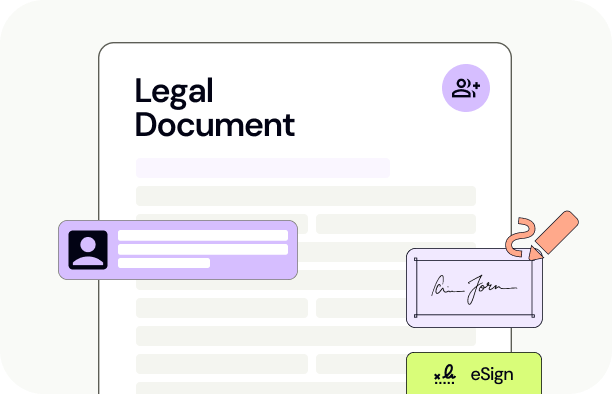Joint Venture Agreement
A Joint Venture Agreement allows two or more parties to enter into a legally binding business contract.
Last updated October 24, 2025
Suitable for Australia


Browse our 500+ legal documents
Browse our 500+ legal documents
Manage documents, agreements and a lot more from one central place. Just log in and find everything ready to go.

Collaborate with e-Sign and Sharing
Collaborate with e-Sign and Sharing
Having access to your legal documents has never been easier. You can request e-signature, share the document and download for an efficient collaboration.

Instantly review any legal document
Instantly review any legal document
Upload your document, ask contract AI, and watch those burning questions transform into crystal-clear answers. Because brilliant decisions shouldn't keep you waiting.
How to create a legal document
- check_circle
Access the Document Library
- check_circle
Select the template that matches your needs
- check_circle
Customise by adding or removing clauses with assistance from Lawpath AI
- check_circle
Personalise with your headers, footers, logos, or additional text
- check_circle
Store all documents securely in your account for easy access
Frequently asked questions
What does the Joint Venture Agreement cover?
- Both parties’ business objectives;
- Roles and responsibilities of each party to the agreement;
- Distribution of cost;
- Profit sharing;
- Liability;
- Dispute resolution;
- Termination.
Other names for Joint Venture Agreement include:
- Joint undertaking
- JV Agreement
- Co-Venture Agreement
What are the differences between a joint venture agreement and a partnership agreement?
A common mistake often made is treating the terms ‘partnership agreement’ and ‘joint venture agreement’ interchangeably. Although the two are similar on the face of it, there are in fact distinct differences.
Should I use a partnership agreement or a joint venture agreement?
A partnership agreement is a legal relationship between two or more individuals, carrying on a business in common with a view of profit. To ensure a professional relationship between partners, it is common that mutual aims and intentions are agreed upon, and often that the partners share the same skill or profession. A partnership ma be legally incorporated.
A joint venture is a less formal legal relationship that allows individuals, or businesses, to work on a project together. The essential terms are generally set out in a written joint venture agreement. Such an agreement commonly identifies that the individuals have not formed a partnership.
A joint venture agreement allows the individuals to have access to new markets, technology and staff. If flexibility is a key feature you’re looking for in a partnership business then the joint venture agreement may be more fitting for you. With the ability to share financial risks individuals are able to approach each other (even if they’re competitors!).
Advantages of a Joint Venture Agreement
- Greater flexibility in terms of tax
- Liability for debts of joint ventures is stipulated to be separate
- Partners are not bound to other partners
Disadvantages of Joint Venture Agreement:
- Joint venture parties are able to avoid fiduciary duties
- No joint enterprise
- Potential conflicts and disputes without the help of a written partnership agreement
Advantages of a Partnership Agreement:
- Partnerships are subject to regulation acts of their respective states and territories, enforcing accountability
- Selling and/or receiving income jointly
- Internal rights to control/manage the partnership
Disadvantages of a Partnership Agreement:
- Partners are jointly and severally liable for debts incurred in the course of their partnership
- Partners cannot enter into their own financing agreements
- Complex issues arise around the way in which assets are held
View Sample Joint Venture Agreement

The Legal Risk Score of a Joint Venture Agreement Template is Low
Our legal team have marked this document as low risk considering:
- The agreement outlines specific terms regarding the ownership and sharing of Intellectual Property (IP) created during the collaboration, which could lead to potential conflicts or misunderstandings about the rights and usage of such IP if not clearly understood and managed.
- The document requires the parties to collaborate closely on various projects, which involves significant coordination and mutual reliance on timely and effective execution, posing a risk if either party fails to meet their obligations or expectations.
- The agreement includes provisions for sharing profits and handling financial contributions, which could lead to disputes or financial discrepancies if the project outcomes do not align with initial expectations or if financial contributions are not managed transparently.
Looking for more documents?
Privacy Policy
A Privacy Policy outlines how your business will use, store and collect your customers' information. A Privacy Policy is required by law in certain circumstances.
Loan Agreement
This Loan Agreement can be used by lender when offering a loan to a Borrower.
Non-Disclosure Agreement (Mutual)
A Non-Disclosure Agreement (Mutual) allows you and another party to share confidential information while legally forbidding either party from disclosing that information to any other person or entity.
Non-Disclosure Agreement (One Way)
A Non-Disclosure Agreement (One Way) allows you and another party to share confidential information while legally forbidding the other party from disclosing that information to any other person or entity.
Business Sale Agreement
A Business Sale Agreement is used to clearly set out all relevant terms of the sale when selling or buying a business.
Shareholders Agreement
A Shareholders Agreement allows you to clarify the relationship between shareholders of your company.
Services Agreement (Pro-Supplier)
This Services Agreement (Pro-Supplier) sets out the relationship between you, the service provider, and the business receiving the services. This version of the Services Agreement is drafted in favour of the supplier from a commercial and legal perspective.
Discretionary Trust Deed
A Discretionary Trust Deed is used to establish a discretionary trust in any state or territory in Australia.
